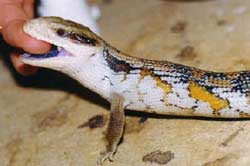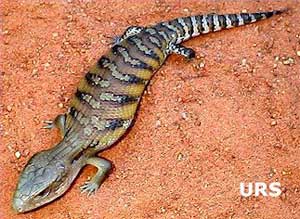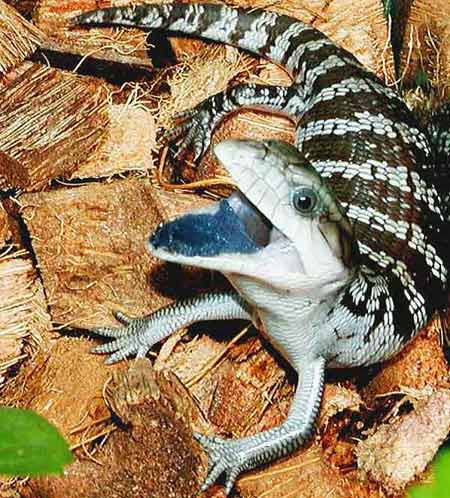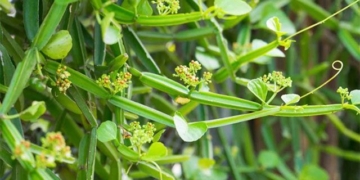 In the northern, eastern, and southeastern regions of Australia, there exists a species of lizard scientifically known as Tiliqua scincoides. Although they belong to the lizard family, they do not prefer climbing trees and are completely adapted to a life spent underground.
In the northern, eastern, and southeastern regions of Australia, there exists a species of lizard scientifically known as Tiliqua scincoides. Although they belong to the lizard family, they do not prefer climbing trees and are completely adapted to a life spent underground.
Their external appearance is quite recognizable: a large head, a long, heavy body (approximately 0.5 meters in length), short legs, each foot having five toes. Their back is colored silver-gray or brown, adorned with a series of horizontal black stripes. The belly and neck can be white, gray, or yellow. The tail measures about 50-70% of the body length, tapering and rounded like a bamboo shoot. The entire body is covered with shiny scales that overlap each other.
One notable feature is their long, blue tongue, which they use to intimidate.
Tiliqua scincoides primarily forages during the day, feeding mainly on insects and gastropods (like snails), and they also consume various types of berries and flowers. At night, instead of perching high like many other lizards, they take refuge in hollow logs or burrow under piles of debris to sleep.
 Typically, this lizard is quite sluggish, but when threatened, it can run surprisingly fast. The blue-tongued lizard has an effective distraction technique: it is willing to “sacrifice” its tail, creating a diversion that can mislead predators into thinking the wriggling tail is a live creature. Taking advantage of this distraction, the tailless lizard can easily escape. Nature has bestowed upon them a peculiar gift: when the tail is severed, very little blood is lost. Losing a tail is not a significant loss: the tail will regrow after some time.
Typically, this lizard is quite sluggish, but when threatened, it can run surprisingly fast. The blue-tongued lizard has an effective distraction technique: it is willing to “sacrifice” its tail, creating a diversion that can mislead predators into thinking the wriggling tail is a live creature. Taking advantage of this distraction, the tailless lizard can easily escape. Nature has bestowed upon them a peculiar gift: when the tail is severed, very little blood is lost. Losing a tail is not a significant loss: the tail will regrow after some time.
If cornered with no escape, they will turn around, stick out their blue tongue… to scare off the threat while hissing.
The reproductive habits of Tiliqua scincoides are also quite unusual: Females lay eggs, but the eggs do not immediately exit the mother’s body; they remain within the lizard. Each time, an average of about 20 eggs are laid. After some time, the eggs hatch right inside the mother’s body. Consequently, it may appear that the mother is giving birth to young ones immediately, with each “release” resulting in 5 to 25 hatchlings being born.
Tiliqua scincoides inhabit coastal forests, mountainous areas, and expansive grasslands.


















































